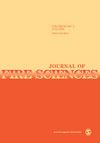飞机货舱灭火系统安全性的数值评估
IF 1.9
4区 工程技术
Q2 ENGINEERING, MULTIDISCIPLINARY
引用次数: 2
摘要
飞机货舱发生火灾可能导致灾难性后果。因此,消防安全是飞机设计和认证过程中最重要的考虑因素之一。在这种情况下,通常使用基于哈龙的灭火剂进行灭火。然而,1994年《蒙特利尔议定书》下的一项国际协议禁止进一步生产哈龙和其他几种被认为对环境有害的卤代烃。因此,需要新的抑制剂以及合适的系统设计和认证。本文旨在描述使用计算流体动力学验证灭火系统初步设计的机制的创建,并为飞机货舱中的灭火实验提供进一步的指导。使用数字代码“火灾动力学模拟器”对地表燃烧火灾进行了调查,这是《最低性能标准》中规定的火灾测试场景之一。这项研究调查了氮的使用和性能,氮是哈龙1301的潜在替代品,是一种环保的货物灭火剂。针对地面燃烧火灾场景,使用热解模型和火灾设计模型建立了基准火灾。与实验结果相比,两个计算流体动力学模型高精度地捕捉到了抑制过程,并显示出相似的温度和气体浓度分布。利用不同火灾增长率的火灾曲线研究了系统不确定性对火灾后果的影响。结果表明,与基于Halon 1301的系统相比,使用氮气作为灭火剂可以实现更低的灭火后温度。因此,它可以被视为飞机货物灭火的潜在候选者。此类工作将直接纳入早期设计阶段的系统安全评估,在早期设计阶段,必须在测试之前进行分析。为应用该模型而提出的未来工作可以扩展到其他火灾场景,如建筑、航运和地面运输车辆。本文章由计算机程序翻译,如有差异,请以英文原文为准。
Numerical assessment for aircraft cargo compartment fire suppression system safety
Fire on board an aircraft cargo compartment can lead to catastrophic consequences. Therefore, fire safety is one of the most important considerations during aircraft design and certification. Conventionally, Halon-based agents were used for fire suppression in such cases. However, an international agreement under the Montreal Protocol of 1994 banned further production of Halon and several other halocarbons considered harmful to the environment. There is therefore a requirement for new suppression agents, along with suitable system design and certification. This article aims to describe the creation of a mechanism to validate a preliminary design for fire suppression systems using Computational Fluid Dynamics and provide further guidance for fire suppression experiments in aircraft cargo compartments. Investigations were performed for the surface burning fire, one of the fire testing scenarios specified in the Minimum Performance Standard, using the numerical code Fire Dynamics Simulator. This study investigated the use and performance of nitrogen, a potential replacement for Halon 1301, as an environmentally friendly agent for cargo fire suppression. Benchmark fires using the pyrolysis model and fire design model were built for the surface-burning fire scenario. Compared with experiment results, the two Computational Fluid Dynamics models captured the suppression process with high accuracy and displayed similar temperature and gas concentration profiles. Fire consequences in response to system uncertainties were studied using fire curves with various fire growth rates. The results suggested that using nitrogen as a fire suppression agent could achieve a lower post-suppression temperature compared to a Halon 1301-based system. It can therefore be considered as a potential candidate for aircraft cargo fire suppression. Such work will feed directly into system safety assessments during the early design stages, where analyses must precede testing. Future work proposed for the application of this model can be extended to other fire scenarios such as buildings, shipping, and surface transport vehicles.
求助全文
通过发布文献求助,成功后即可免费获取论文全文。
去求助
来源期刊

Journal of Fire Sciences
工程技术-材料科学:综合
CiteScore
4.00
自引率
0.00%
发文量
14
审稿时长
2.5 months
期刊介绍:
The Journal of Fire Sciences is a leading journal for the reporting of significant fundamental and applied research that brings understanding of fire chemistry and fire physics to fire safety. Its content is aimed toward the prevention and mitigation of the adverse effects of fires involving combustible materials, as well as development of new tools to better address fire safety needs. The Journal of Fire Sciences covers experimental or theoretical studies of fire initiation and growth, flame retardant chemistry, fire physics relative to material behavior, fire containment, fire threat to people and the environment and fire safety engineering. This journal is a member of the Committee on Publication Ethics (COPE).
 求助内容:
求助内容: 应助结果提醒方式:
应助结果提醒方式:


